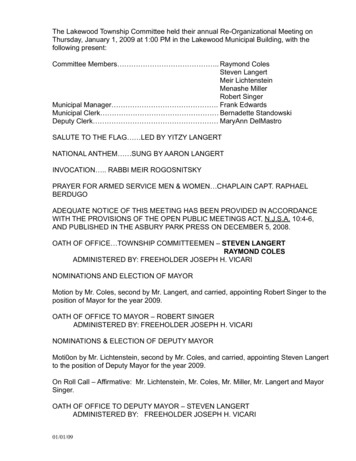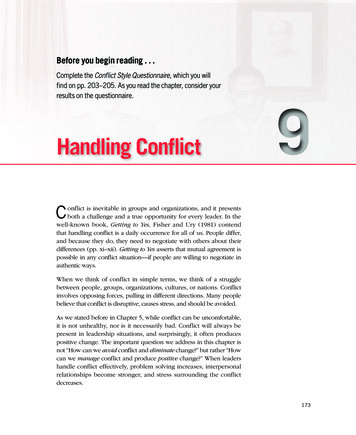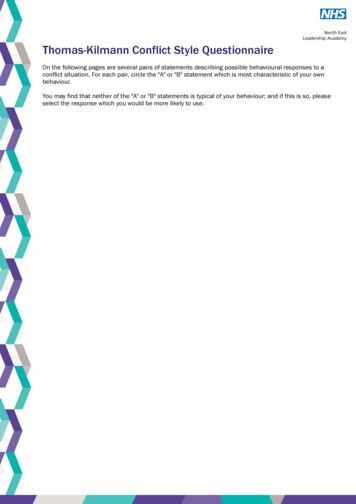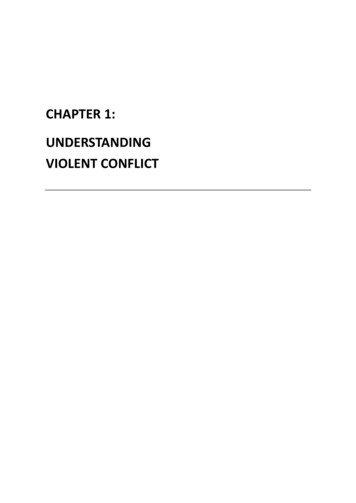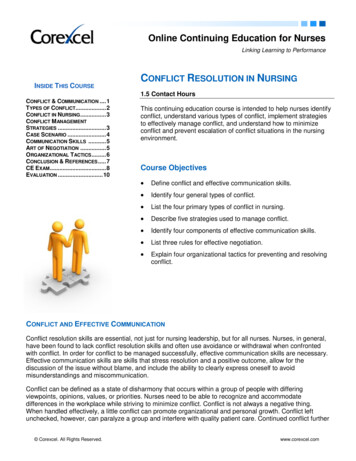
Transcription
Online Continuing Education for NursesLinking Learning to PerformanceINSIDE THIS COURSECONFLICT RESOLUTION IN NURSING1.5 Contact HoursCONFLICT & COMMUNICATION . 1TYPES OF CONFLICT. 2CONFLICT IN NURSING . 3CONFLICT M ANAGEMENTSTRATEGIES . 3CASE SCENARIO . 4COMMUNICATION SKILLS . 5ART OF NEGOTIATION . 5ORGANIZATIONAL TACTICS . 6CONCLUSION & REFERENCES . 7CE EXAM . 8EVALUATION . 10This continuing education course is intended to help nurses identifyconflict, understand various types of conflict, implement strategiesto effectively manage conflict, and understand how to minimizeconflict and prevent escalation of conflict situations in the nursingenvironment.Course Objectives Define conflict and effective communication skills. Identify four general types of conflict. List the four primary types of conflict in nursing. Describe five strategies used to manage conflict. Identify four components of effective communication skills. List three rules for effective negotiation. Explain four organizational tactics for preventing and resolvingconflict.CONFLICT AND EFFECTIVE COMMUNICATIONConflict resolution skills are essential, not just for nursing leadership, but for all nurses. Nurses, in general,have been found to lack conflict resolution skills and often use avoidance or withdrawal when confrontedwith conflict. In order for conflict to be managed successfully, effective communication skills are necessary.Effective communication skills are skills that stress resolution and a positive outcome, allow for thediscussion of the issue without blame, and include the ability to clearly express oneself to avoidmisunderstandings and miscommunication.Conflict can be defined as a state of disharmony that occurs within a group of people with differingviewpoints, opinions, values, or priorities. Nurses need to be able to recognize and accommodatedifferences in the workplace while striving to minimize conflict. Conflict is not always a negative thing.When handled effectively, a little conflict can promote organizational and personal growth. Conflict leftunchecked, however, can paralyze a group and interfere with quality patient care. Continued conflict further Corexcel. All Rights Reserved.www.corexcel.com
Page 2Conflict Resolution in Nursingleads to higher staff turnover rates, increased healthcare costs, patient dissatisfaction and an overalldecrease in organizational morale.Quality and safe patient care depends on a collaborative work environment that stresses teamwork andcommunication. The Joint Commission developed a leadership standard, effective January 1, 2009, toaddress issues of conflict in the workplace. This standard calls for an organizational code of conduct thatdefines acceptable versus disruptive or inappropriate behaviors. The standard also calls for leaders tocreate and implement processes to effectively manage conflict in the workplace. The Joint Commissionreport also identifies two main factors involved in healthcare workplace conflict: Personal Factors: The Joint Commission reports that the stress involved when dealing with highemotion situations, especially when coupled with fatigue can lead to intimidating or disruptiveindividual behavior. Healthcare professionals who possess characteristics such as selfcenteredness, immaturity or defensiveness are more prone to these types of behavior and oftenlack interpersonal, coping, or conflict management skills. Organizational Factors: The same report also points out how the uniqueness of the healthcarecultural environment can create challenges for interpersonal communication and trust issuesbetween team members. The healthcare environment is marked by productivity demands, costcontainment issues, embedded hierarchies and the ever-present fear and stress caused by thepossibility of litigation. A continual flux of change is present in healthcare, further contributing to anenvironment where conflict can be expected and must be dealt with effectively for positiveoutcomes.GENERAL TYPES OF CONFLICTIn order to effectively assess a conflict situation, it is important to understand the main types of conflict.Each type of conflict requires a different approach for effective management. Intrapersonal Conflict: This type of conflict occurs within a person when confronted with asituation that causes discomfort. Intrapersonal conflict can affect others working with the nurse whois experiencing this type of conflict and lead to the next type of conflict. An example of intrapersonalconflict is a nurse who is working a shift that interferes with her family schedule and is creatingconflicting emotions in that nurse. Interpersonal Conflict: This type of conflict occurs between two or more people who disagree onan issue due to factors such as differing goals, values, ethics, or priorities. This is the most commontype of workplace conflict. An example of interpersonal conflict is a situation where a family memberis angry with a nurse over a treatment or medication change. Intergroup Conflict: This type of conflict is similar in nature to interpersonal conflict, but occursbetween two or more groups of people. An example is a disagreement between two units about thebest way to transfer a patient and provide a handoff report. Organizational Conflict: This type of conflict occurs when there is a disagreement between staffand the organization over issues including policies and procedures, changes occurring on the unit,or organizational standards. An example is an organizational change in documentation the nursesfeel is unnecessary or redundant. Corexcel. All Rights Reserved.www.corexcel.com
Page 3Conflict Resolution in NursingPRIMARY TYPES OF CONFLICT IN NURSING Nurse-to-Nurse Conflict: This type of conflict occurs whennurses clash over philosophies, experience, or collusion.Nurse-to-nurse conflict can escalate to incivility which mayresult in bullying or lateral workplace violence. Lateralviolence refers to hostile acts between workplace colleagues.Examples of this type of violence include covert or overt actsof verbal or nonverbal aggression and may lead to bullyingbehavior. Because this type of conflict can escalate quicklyand directly affect patient care, it is important that it is quicklyrecognized and resolved. Nurse-to-Physician Conflict: This type of conflict arises asa difference in power or perception of power. Communicationcan become condescending, critical, or patronizing. This typeof conflict can affect all members of the staff and inhibitpatient care by interfering with interprofessionalcollaboration. Steps must be taken to improve nurse and physician communication which stressesthe shared goal of patient-centered care. Nurse-to-Patient Conflict: Patient and family members who do not feel they are being heard or arenot part of the decision-making process may lead to conflict situations. Patients may feel a nurse isnot answering their call bells promptly, ignoring their pain, not giving their medications on time, orare speaking to them in a condescending or abrasive manner.Nurses who can remain mindful and not become defensive are able to communicate moreeffectively with the patient or family members and discuss issues as they arise, thus preventingfurther frustration or escalation. Care must be taken to ensure that patients and/or family membersare actively engaged in the decision-making process. Staffing Conflicts: Staffing and scheduling issues are common sources of both internal andexternal conflicts. The process of nurse staffing requires the balancing of quality patient care withthe number and needs of staff nurses. Because of the ever-present change that is part of theprocess, conflict can arise over this issue that affects nursing staff, patients, and other teammembers.Ideally, staffing should include the input of the nurses to work together in a collaborative process tocreate a fair and balanced schedule as much as possible. However, no matter how staffingschedules are determined, transparency is key to minimizing conflict and promoting safety, a senseof community, and overall job satisfaction among staff members.CONFLICT MANAGEMENT STRATEGIESThere are five main types of strategies used to manage conflict. Not all types are effective in all conflictsituations. Often, a combination of the following strategies can be used to effectively deal with conflict in theworkplace. Avoiding: This strategy is the least effective method of dealing with conflict because nothing isresolved, only postponed. However, in a volatile situation sometimes using the avoidance strategyto walk away and clear your head may be the best strategy to use. Accommodation: This strategy is also considered largely ineffective because it often results infuture conflict. Accommodation involves putting someone else’s needs or goals ahead of someone Corexcel. All Rights Reserved.www.corexcel.com
Page 4Conflict Resolution in Nursingelse’s (often your own) at a sacrifice. This strategy may temporarily resolve the conflict, but leads toa build-up of frustration and resentment. Competing: This strategy involves someone pursuing their own goals, needs or desires at theexpense of others. While some competition may benefit the workplace, using competing as astrategy to management conflict leads to aggression and anger and is often found in powerstruggles. Compromising: This is considered an effective strategy to deal with conflict. In this method, bothparties are willing to give something up in order to gain something. This strategy is only effective ifboth parties feel their trade-offs are fair and equal. Collaborating: This strategy is considered the best method for effective conflict management. Bothparties identify shared goals and work together in a fashion where both parties are satisfied with theoutcome.CASE SCENARIONurse R arrives for her 12-hour shift in the emergency room department and finds that her assignment isquite heavy. She has been assigned seven patients, including two who are currently unstable. She noticesthat Nurse M has a light assignment with only five patients, all of whom are scheduled to be discharged tohome during the shift. She feels frustrated because her patient load exceeds the ER guidelines regardingpatient number and acuity. She knows Nurse M often receives lighter assignments because she is knownto be intimidating and aggressive. She decides to address the issue with her charge nurse who tells hershe is busy and “it is what it is.” Increasingly frustrated, Nurse R decides it is time to approach the unitmanager about this ongoing issue.What are some ways the nurse manager can address the issue and manage this conflict situationeffectively?A. Avoidance: The nurse manager can choose to avoid the situation and say nothing or tell NurseR she is too busy to address the situation.Results: Nurse R walks away feeling more frustrated and powerless over the situation.B. Competing: The nurse manager can become dominating and tell the charge nurse theassignment is unacceptable and needs changed immediately.Results: The charge nurse is upset and angry at both Nurse R and the manager. The managerlater feels regret that she handled the conflict in this manner and has caused more stress anddiscord on the unit. Nurse R gets the results she wanted, but now is at odds with her chargenurse and the other nurse on the unit.C. Compromise: The nurse manager can discuss Nurse R’s concerns with the charge nurse andengage her assistance to find a speedy solution that will make both nurses happy.Results: By engaging the charge nurse and asking for her help, the manager can address thesituation without escalating it. If they can work together to find a solution that works for bothnurses, this approach may result in a positive outcome.D. Collaboration: The manager can have an informal meeting with both nurses and the chargenurse where they can discuss ways they can all come to an acceptable solution. Corexcel. All Rights Reserved.www.corexcel.com
Page 5Conflict Resolution in NursingResults: Each party can give input and feel their opinion is important and heard bymanagement. With all involved parties included, each will be more willing to compromise for theoverall benefit of everyone on the unit including other staff members and patients. This solutionoffers the best way for a speedy resolution while also improving patient care and patientoutcomes.Collaboration is considered the most effective method of conflict management.EFFECTIVE COMMUNICATION SKILLS FOR CONFLICT MANAGEMENTThe first step in managing any conflict is to develop communication skills that are effective and producepositive results. Some points to remember for effective communication during conflict management includethe following four strategies: Mutual Respect: Both parties must remain respectful towards the other party and keep the focuson the issue and not resort to personal attacks. Needs Versus Wants: Each party should examine whether their issue is a need or a want, as wellas seek to understand the other party and their needs and wants. Clarifying this point can improvecollaboration and compromise during a conflict. Compassion and Empathy: Both parties must act with compassion and empathy to the other partyif conflict is to be managed effectively. Both parties must be willing to actively listen to the otherparty with an open mind and without becoming defensive. Stay in the “I”: Each party needs to stay focused on “I” statements and not fall into the habit ofusing accusatory “you” statements which often lead to an increase in conflict and create anenvironment of blame.THE ART OF NEGOTIATIONA critical communication skill during conflict situations is the ability to effectively negotiate. Negotiationinvolves controlling reactions during the conflict, seeking to actively listen and understand the other party’sissues, identifying the unmet need, and being able to compromise and collaborate to come to a positivesolution. There are three rules to remember when using negotiation to solve a conflict:1. Do not take negative comments or information presented personally. Instead, listen to the otherparty with an open mind while trying to determine the core of the actual problem. While it maybe a normal reaction to become angry and defensive when faced with criticism, effectivecommunication and negotiation requires both parties seek to understand the other party andcollaborate to find an effective solution.2. The second rule involves identifying the need being expressed by the other party. Is the need apersonal need, an institutional need, or a patient need? By staying in control of your ownemotions and identifying the unmet need, you can move on to the third rule in successfulnegotiating, which is finding a solution. Corexcel. All Rights Reserved.www.corexcel.com
Page 6Conflict Resolution in Nursing3. The third rule focuses on finding a positive solution for all the parties involved. To accomplishthis, each party must be willing to give something up, or to compromise. Although it may bedifficult to give something up in the immediate short-term, by keeping long-term goals in mind, itbecomes easier to negotiate conflict situations as they arise.Three Rules of Negotation1. Don’t take it personally.2. Identify the need.3. Focus on a solution.ORGANIZATIONAL TACTICS FOR PREVENTING AND RESOLVING CONFLICTConflict in the workplace can also be seen as a disagreement where one or more parties perceives a threatto their needs, wants, or concerns. Organizational leaders can do much to prevent or resolve conflict and topromote a company culture where collaboration and cooperation are the norm. These four steps can assistnurse managers and leaders in their role to prevent or resolve conflict: Engage in Dialogue: The organization and management need to be willing to engage in dialogue.Nurses should have the opportunity to speak at councils or meetings and give their perceptive andconcerns on issues that are currently creating conflict or have the potential to create conflict. Thisimportant step will often be enough to prevent the conflict from continuing or escalating. Debriefing and Education: Staff conflict needs to be identified as an opportunity for dialogue andcommunication skills training. Nonpunitive debriefing after a conflict situation allows everyone toreflect on the incident and seek ways to learn from it. Role-playing and the use of case scenarioscan be helpful in preventing or minimizing conflict by teaching effective communication skills andproviding a non-threatening environment to practice these skills. This allows nurses to feel betterprepared and more confident in real-life conflict situations. Identify Potential Conflict: Organizational leaders can help identify potential areas for conflict anddevelop policies and procedures to handle conflict that may occur. Conflict is inevitable in theworkplace, especially in fast-paced healthcare settings with various disciplines working together inhigh-stress situations. By becoming aware of where potential conflict situations are likely to occur,the organization can prepare the staff and provide tools and guidance to handle the situationeffectively. Recognize Conflict Early: If conflict is not managed effectively, it often continues to grow andescalate. Nurse managers and other organizational leaders must receive the necessary training torecognize conflict in the early stages and be prepared to act as a guide towards successfulresolution. This step produces a workplace that focuses on cooperation and collaboration. Corexcel. All Rights Reserved.www.corexcel.com
Page 7Conflict Resolution in NursingCONCLUSIONConflict is an inevitable part of any healthcare workplace environment.Although conflict can cause stress and fear, with the right tools, conflict canbe seen as an opportunity for growth. Effective communication skills, roleplaying, and case scenarios can be used by nurses to manage conflict in away that results in a positive outcome for each party.REFERENCESCardilla, D. (2017). Seven strategies for managing conflict. The Iowa Nurse Reporter, pp.8-10.Dahlkemper, T. (2017). Nursing leadership, management, and professional practice for the lpn/lvn, 6e.(2017). Retrieved from u.Johansen, M. (2012). Keeping the peace. Nursing Management (Springhouse), 43(2), pp.50-54.Jointcommission.org. (2017). Available at: https://www.jointcommission.org/assets/1/18/SEA 40.PDF[Accessed 4 Nov. 2017].Mahon, M.; Nicotera, A. (2011). Nursing and conflict communication: avoidance as preferred strategy.Nursing Administration Quarterly, ISSN: 1550-5103, Vol: 35, Issue: 2, Page: 152-63.ADDITIONAL CONFLICT RELATED RESOURCESEverything DiSC Productive ConflictEverything DiSC Productive Conflict is a behavior assessment, and available presentation materials, thatgives participants the tools to turn conflict into productivity. Assessment & Trainer Materials Demo Request FormHandling Workplace ConflictHandling Workplace Conflict is an online course that helps managers understand employee conflictstyles, identify causes of conflict, and implement strategies for addressing conflict. Online Course Corexcel. All Rights Reserved.www.corexcel.com
Page 8Conflict Resolution in NursingCE EXAMCONFLICT RESOLUTION IN NURSING1.Conflict can be defined as a state of disharmony that occurs within a group of people with differingviewpoints, opinions, values, or priorities.A.B.2.This type of conflict occurs between two or more people who disagree on an issue due to factors suchas differing goals, values, ethics, or priorities. This type of conflict is the most common type ofworkplace conflict.A.B.C.D.3.Staffing conflictNurse-to-Nurse conflictNurse-to-Physician conflictNurse-Patient conflictLateral workplace violence does not include covert or overt acts of verbal aggression.A.B.5.Intrapersonal conflictInterpersonal conflictIntergroup conflictOrganizational conflictThis type of conflict occurs when nurses clash over philosophies, experiences, or collusion.A.B.C.D.4.TrueFalseTrueFalseThis conflict management strategy is considered the least effective method of dealing with conflictbecause nothing is really resolved, only laborating Corexcel. All Rights Reserved.www.corexcel.com
Page 96.Successfully being able to negotiate in a conflict situation requires the ability to define unmet needs ofthe other party.A.B.7.Staffing conflictNurse-to-Nurse conflictNurse-to-Physician conflictNurse-Patient conflictThe Joint Commission report identifies two main factors involved in healthcare workplace conflict aspersonal and organizational factors.A.B.9.TrueFalseThis type of conflict occurs in the healthcare workplace when there is a difference in power orperceptions of power.A.B.C.D.8.Conflict Resolution in NursingTrueFalseThis conflict management strategy involves someone pursuing their own goals, needs, or desires atthe expense of ating10. Role-playing and the use of case scenarios can be helpful in teaching effective communication skills,but are also a source of conflict and tension.A.B.TrueFalse Corexcel. All Rights Reserved.www.corexcel.com
Page 10Conflict Resolution in NursingEVALUATIONCONFLICT RESOLUTION IN NURSINGPlease answer the following questions by circling the response thatbest represents your eeDisagreeCOURSE OBJECTIVES & CONTENT1.The activity met the stated learning objectives.543212.The content was up to date.54321TEACHING/LEARNING METHODS3.The teaching/learning methods, strategies, andslides were effective in helping me learn.543214.The material was clearly explained.543215.The answers to the post-test questions wereappropriately covered in the activity.54321OVERALL ACTIVITY6.The online course/download supported theachievement of the stated learning objectives.543217.The material was relevant to my professionaldevelopment.543218.Overall, I am pleased with this activity andwould recommend it to others.YesNo9.The content was presented free of commercialbias.*YesNo10.Did the material presented increase yourknowledge and/or understanding of this topic?**YesNoNAContinued on Next Page Corexcel. All Rights Reserved.www.corexcel.com
Page 11Conflict Resolution in Nursing* If you responded “No” to question 9, please explain why:* If you answered “Yes” to question 10, what change do you intend to make?What barrier, if any, may prevent you from implementing what you learned?Cite one new piece of information you learned from this activity:Additional comments/suggestions:With my signature I confirm that I am the person who completed this independent educational activity by reading thematerial and completing this self evaluation.Signature Corexcel. All Rights Reserved.Date:www.corexcel.com
Page 12Conflict Resolution in Nursing201 Webster Building3411 Silverside RoadWilmington, DE mHOW TO GET YOUR CONTINUING EDUCATION CREDITTo receive ANCC continuing education credit for this learning packet, you must read the course content,pass the post-test, complete the evaluation, and submit the registration form by January 1, 2024.You may fax the forms to Corexcel at 302-477-9744 or mail them to:Corexcel201 Webster Building3411 Silverside RoadWilmington, DE 19810We will mail you the certificate within a week after receiving your test, evaluation and payment as long asyou achieve a 70% or better on the test.Corexcel is accredited as a provider of continuing education in nursing by the American NursesCredentialing Center’s Commission on Accreditation.Accreditation refers to recognition of continuing nursing education only and does not imply Commission onAccreditation approval or endorsement of any commercial product.No planning committee member or faculty has indicated a relevant financial relationship with a commercialinterest involved with the content contained in this course.Corexcel’s provider status through ANCC is limited to educational activities. Neither Corexcel nor theANCC endorse commercial products.Corexcel has been approved as an Authorized Provider by the International Association for ContinuingEducation and Training (IACET), 1760 Old Meadow Road, Suite 500, MacLean, VA 22102.Take Conflict Resolution in Nursing OnlineAll materials contained in this educational activity are protected by United States copyright law and may not be reproduced, distributed, transmitted,displayed, published or broadcast without the permission of Corexcel. You may not alter or remove any trademark, copyright or other notice fromcopies of the content. Corexcel. All Rights Reserved.www.corexcel.com
Page 13Conflict Resolution in Nursing201 Webster Building3411 Silverside RoadWilmington, DE mUNDERSTANDING IMPLICIT BIASThe goal of healthcare is to provide the best possible care to all patients; indeed, many healthcareprofessionals must recite a pledge similar to the Hippocratic oath upon licensure. However, it is possiblefor healthcare professionals to have implicit bias that leads to substandard care.Implicit bias is an unconscious attitude leading to stereotypes that influence thought and action. Not beingaware of this bias can lead to unintentional discrimination in patient assessment and diagnosis,treatment, follow-up care, etc. Discrimination, unconscious or otherwise, in these impacted areas ofhealthcare leads to disparities where disadvantaged patient populations receive unequal care. Patientgroups especially at risk of receiving unequal care may include: Those with lower incomeWomenMinoritiesThose who speak English as a second languageThe elderlyAn example of healthcare disparities can be seen in breast cancer mortality rates. Black women are 41%more likely to die from breast cancer than white women. Additionally, they are less likely to be diagnosedwith stage I breast cancer, but twice as like to die from early breast cancer.Eliminating implicit bias can help reducing disparities in healthcare. Strategies for healthcareprofessionals to remove bias from their practice may include: Regulating emotions – being aware of, and control, thoughts and feelingsBuilding partnerships – working with patients to achieve a common goalTaking perspective – understand the patient perspective during all phases of healthcareRecognizing implicit bias and working to remove it from practice will help healthcare professionals to givethe best care possible to all patients and reduce the disparities between patient populations.REFERENCESAlspach, J. Implicit bias in patient care: an endemic blight on quality care. Crit Care Nurse (2018) 38 (4):12–16.Aujero, M. Breast cancer screening for at risk women. Oral presentation at: 23rd Annual Breast CancerUpdate; February, 2021; Wilmington, DE.Narayan, M. CE: addressing implicit bias in nursing: a review. Am J Nurs (2019) 119 (7): 36-43. Corexcel. All Rights Reserved.www.corexcel.com
Page 14Conflict Resolution in Nursing201 Webster Building3411 Silverside RoadWilmington, DE mWRITTEN PROGRAM REGISTRATION FORMDate:Name & Title:Address:City:State:Zip:License No. (Required for Florida):Email:Employer:(W):(H):(F):Have you registered with us before?Course #CX0110YesTitleAmount21.00Conflict Resolution in NursingShipping and Handling8.95TotalPaying By: 29.95CheckCredit CardMoney OrderCredit Card Number:Exp. Date:Cardholders Name:Sec. Code: Corexcel. All Rights Reserved.NoCashwww.corexcel.com
Identify four components of effective communication skills. List three rules for effective negotiation. Explain four organizational tactics for preventing and resolving conflict. CONFLICT AND EFFECTIVE COMMUNICATION Conflict resolution skills are essential, not just for nursing lea
